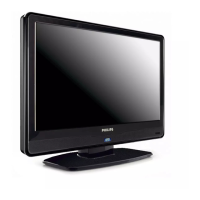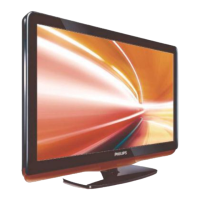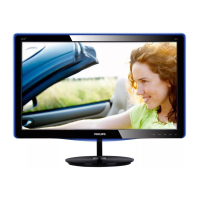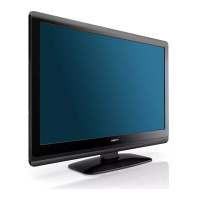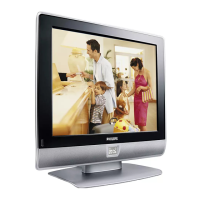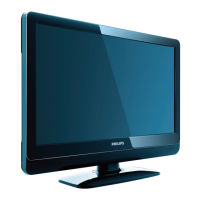
Do you have a question about the Philips 22HFL4372D/10 and is the answer not in the manual?
| Screen Size | 22 inches |
|---|---|
| Resolution | 1920 x 1080 pixels |
| Display Type | LCD |
| Screen shape | Flat |
| Aspect ratio | 16:9 |
| Contrast Ratio | 1000:1 |
| Contrast ratio (typical) | 1000:1 |
| Response time | 5 ms |
| Display brightness | 250 cd/m² |
| HD type | Full HD |
| HDMI Ports | 2 |
| USB Ports | 1 |
| USB 2.0 ports quantity | 1 |
| RMS rated power | 10 W |
| Sound Output | 10 W |
| Refresh Rate | 60 Hz |
| Display diagonal | 22 inches |
General safety precautions for TV operation and handling.
Identifies physical buttons and indicators on the TV.
Steps to navigate to a specific teletext page.
How to use teletext features like freeze, dual screen, and reveal.
Setting primary and secondary teletext languages.
How to navigate subpages within teletext.
Finding specific words or numbers within teletext.
Explains the functions and benefits of the Electronic Programme Guide.
Steps to access and activate the Electronic Programme Guide.
How to set the TV to switch to standby after a set period.
Setting the TV to switch on at a specific time or channel.
Setting age restrictions for TV programs.
How to show the current time on the TV screen.
Setting automatic, manual, or country-dependent clock synchronization.
Enabling or disabling daylight saving time.
Viewing photos, music, and videos from USB storage devices.
Displaying photos as a slideshow with playback controls.
Steps to set a picture as a TV wallpaper.
Activating features for visually or hearing impaired users.
Adjusting audio volume for visually impaired users.
Enabling audio cues for button presses for the visually impaired.
Guides through initial TV setup for picture and sound.
Selecting pre-defined picture modes for optimal viewing.
Advanced options for adjusting picture contrast, brightness, color, etc.
Rearranging the order of channels in the list.
Assigning custom names to TV channels.
Making channels invisible in the channel list.
Making hidden channels visible again in the list.
Setting up channels automatically by scanning.
Manually searching and storing analogue TV channels.
Tuning digital channels by entering frequency.
Setting preferred languages for audio, subtitles, and teletext.
Selecting the language for the TV menu interface.
Adjusting settings to reduce energy consumption.
Synchronizing TV picture with audio from a home theatre system.
How to show the current time on the TV screen.
Setting automatic, manual, or country-dependent clock synchronization.
Enabling or disabling daylight saving time.
Checking the current installed software version on the TV.
Updating TV software using a USB flash drive.
Explains the purpose and benefits of Professional mode.
Details the advantages of operating the TV in Professional mode.
Configuring PBS setup menu language and mode.
Customizing welcome messages displayed when the TV is switched on.
Locking the TV's physical buttons to prevent changes.
Disabling or enabling the guest remote control buttons.
Defining the TV's power-on mode (On, Standby, Last status).
Setting the brightness of the standby clock display.
Setting the brightness of the active clock display.
Manually setting the TV's clock time.
Selecting the source for automatic clock time retrieval.
Configuring multiple remote controls for individual TVs.
Activating PayTV channel lists based on PIN.
Activating customizable themes with channel references.
Selecting VSecure mode (Stand alone, RF Static, RF Dynamic).
Copying VSecure Authorization key to a USB device.
Copying VSecure Unprotect key from USB to the TV.
Performing an internal test for VSecure validation.
Setting DVB parameters to locate VSecure RF channel.
Erasing shared VSecure keys.
Erasing odd VSecure keys.
Erasing even VSecure keys.
Erasing all VSecure keys.
Muting or enabling the main TV speakers.
Controlling headphone/bathroom speaker volume independently.
Setting the default volume for main speakers.
Setting up channel configurations and options.
Displaying channels that were previously hidden.
Hiding current channels from the channel grid.
Configuring PayTV channel lists and options.
Configuring themes and channels for ThemeTV.
Explains guest limitations and available functions.
Describes the remote control designed for predictable behavior.
How to switch the TV on and access menus.
Details the various ports on the back of the TV.
Output for audio and video to analogue devices.
Input for digital audio and video from HD devices.
Analogue audio/video input for DVD players or game consoles.
Audio input for connecting a computer.
Input for antenna, cable, or satellite signal.
Slot for a Conditional Access Module (CAM).
Input for USB storage devices.
High-definition digital input for TVs 26" and larger.
Steps to insert and activate a CAM into the TV.
Turning the EasyLink feature on or off.
List of compatible computer and video resolutions.
Supported USB storage and media file formats.
Specifications for TV tuner, aerial input, and signal types.
Details about the remote control type and batteries.
Power specifications including mains voltage and standby consumption.
Solutions for common problems like TV not switching on.
Troubleshooting missing channels or no digital channels found.
Resolving issues with no picture, or sound without picture.
Fixing unstable computer display on the TV.
